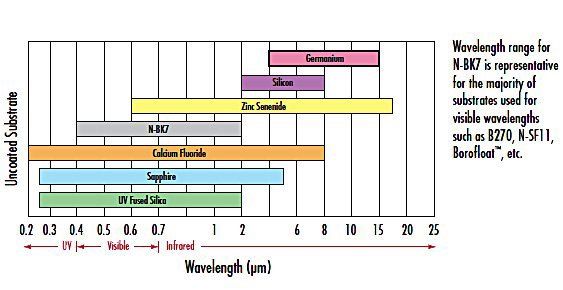
Edmund Optics® offers a variety of substrates for UV and IR applications, including BK7, fused silica, sapphire, calcium fluoride, zinc selenide, silicon, germanium and magnesium fluoride. These substrates are available on many of our stock lenses, windows and a host of other optics.
BK7 is a low cost substrate for visible and NIR applications. It is generally not favored for UV, though it offers good transmission down to 350nm. It is great for machine vision, microscopy, and industrial applications.
Fused silica has a low coefficient of thermal expansion and excellent transmission from UV to IR. It is great for interferometry, laser instrumentation, spectroscopy, and industrial applications.
Sapphire is extremely hard and durable with good transmission from UV to IR. It is great for IR laser systems, spectroscopy and rugged environmental equipment.
Calcium fluoride has low absorption and high damage threshold from 0.2 – 7μm. It is great for spectroscopy, semiconductor processing, and cryogenically cooled thermal imaging.
Zinc selenide has a low absorption coefficient and high resistance to thermal shock. It is great for CO2 laser systems and thermal imaging.
Silicon is a low cost and low density substrate for weight sensitive IR applications. It is great for spectroscopy, mid-IR laser systems, and THz imaging.
Germanium has a high index of refraction and knoop hardness with transmission in the mid and far-IR regions. It is great for thermal imaging, FLIR, and rugged IR applications.
Magnesium Fluoride is extremely rugged and durable with excellent broadband transmission from the DUV to mid-IR regions. It is great for UV and IR laser systems, rugged environmental equipment, and high vibration environments.

or view regional numbers
QUOTE TOOL
enter stock numbers to begin
Copyright 2023, Edmund Optics India Private Limited, #267, Greystone Building, Second Floor, 6th Cross Rd, Binnamangala, Stage 1, Indiranagar, Bengaluru, Karnataka, India 560038
California Consumer Privacy Act (CCPA): Do Not Sell or Share My Personal Information
California Transparency in Supply Chains Act